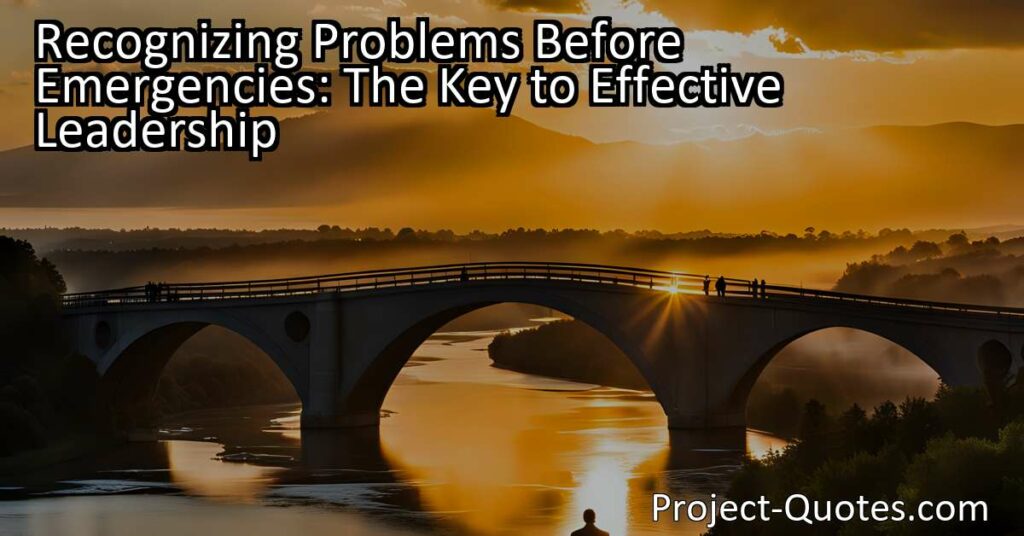One of the tests of leadership is the ability to recognize a problem before it becomes an emergency.
Arnold H. Glasow
Recognizing problems before emergencies is a vital quality of effective leadership. It requires being observant, thinking critically, and having the courage to take action. By addressing issues early on, leaders can prevent crises and create safe and productive environments in schools, workplaces, and communities.
Table of Contents
Meaning of Quote – One of the tests of leadership is the ability to recognize a problem before it becomes an emergency.
Leadership is often associated with qualities such as bravery, confidence, and the ability to make tough decisions. But there is one crucial aspect of leadership that is often overlooked – the ability to recognize a problem before it becomes an emergency. This quote beautifully encapsulates the essence of this skill, highlighting the significance of foresight and proactive thinking in effective leadership.
To truly understand the importance of recognizing problems before they escalate into emergencies, let us consider a hypothetical scenario. Imagine a captain of a ship who fails to identify a small crack in the hull. Over time, this crack grows larger and eventually leads to a catastrophic failure, causing the ship to sink. In this situation, the captain’s failure to recognize the problem in its early stages resulted in a dire emergency that could have been prevented.
Now, let’s apply this concept to leadership in various real-life scenarios. Whether it’s in a school, a workplace, or even a community, leaders play a crucial role in ensuring the smooth functioning and well-being of their respective environments. By being able to recognize potential problems before they escalate, leaders can take proactive measures to address them in a timely manner, saving valuable time, resources, and potentially even lives.
In a school setting, let us consider the example of a principal who notices a significant increase in behavioral issues among students. Rather than waiting until these issues escalate into serious conflicts or even violence, the principal takes immediate action to implement preventive measures. This could involve organizing counseling sessions, implementing conflict resolution programs, or creating a positive and inclusive school culture. By recognizing the problem early on, the principal is able to address it before it becomes an emergency, thereby fostering a safe and conducive learning environment for all students.
Similarly, in a workplace, a proactive leader can prevent major setbacks by identifying potential problems in employee morale, communication, or productivity. By keeping a pulse on the company’s operations and recognizing early warning signs, a leader can take swift action to rectify the issues. This might involve conducting team-building exercises, providing additional training, or even restructuring certain processes. In doing so, the leader not only prevents emergencies but also fosters a positive work environment where employees feel valued and motivated.
Beyond schools and workplaces, leaders in the community also possess the responsibility of recognizing problems before they become emergencies. Let’s imagine a neighborhood experiencing increasing crime rates. A leader who is attentive to the community’s concerns and proactive in addressing underlying issues could establish community watch programs, collaborate with local law enforcement to increase patrols, or organize events to promote a sense of unity and safety. By anticipating and addressing these problems in their early stages, community leaders can prevent emergencies and cultivate a stronger, more resilient neighborhood.
So, what does it take to be a leader who possesses the ability to recognize problems before they become emergencies? Firstly, leaders must be observant and attentive, paying close attention to the needs and dynamics of their respective environments. This requires actively listening to the concerns of others, conducting regular assessments, and staying informed about relevant developments. By keeping their finger on the pulse of the situation, leaders can identify potential problems in their nascent stages, long before they become full-blown emergencies.
Secondly, leaders must possess the ability to think critically and analyze situations objectively. This entails stepping back and looking at the bigger picture, understanding the potential consequences of unaddressed issues, and identifying trends or patterns that could lead to emergencies. This critical thinking ability allows leaders to connect the dots and take proactive measures before problems spiral out of control.
Lastly, effective leaders must have the courage to take action. Recognizing a problem is one thing, but having the determination and conviction to address it is another. Leaders must be willing to make tough decisions, even if they are unpopular or challenging. By demonstrating their commitment to finding solutions, leaders inspire trust and confidence among their followers, creating a culture of accountability and problem-solving.
In conclusion, the ability to recognize problems before they become emergencies is a crucial test of leadership. Leaders who possess this skill are far more likely to handle challenges effectively and prevent dire situations. Through their observant nature, critical thinking abilities, and courageous actions, leaders can navigate through the complex landscapes they encounter, ensuring the safety, productivity, and well-being of those they lead. By embracing this important aspect of leadership, individuals can develop the skills needed to tackle problems head-on and emerge as successful leaders in their own right.
I hope this quote inspired image brings you hope and peace. Share it with someone who needs it today!


